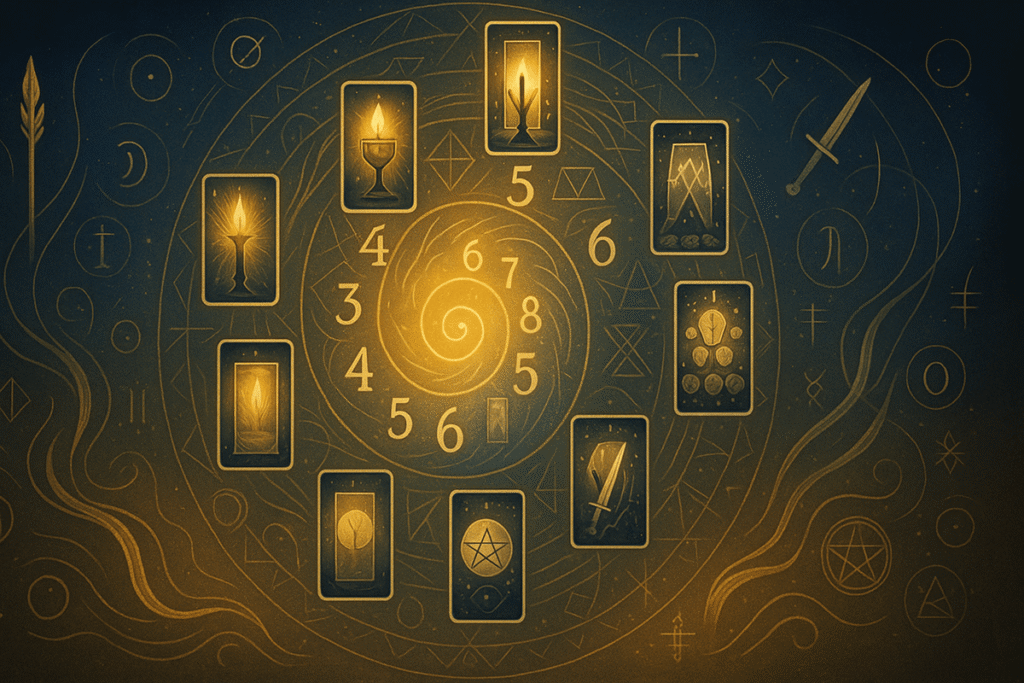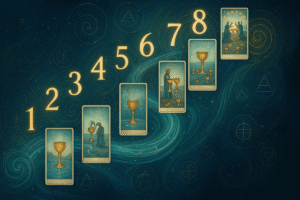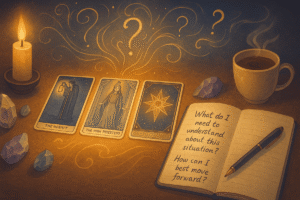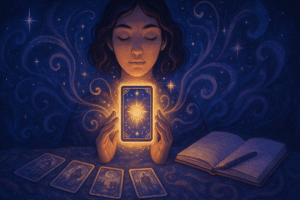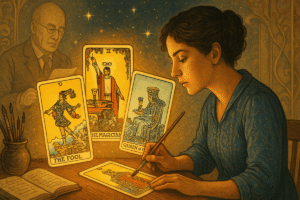Table of Contents
When I first started exploring tarot, I’ll admit the numbered cards felt like a puzzle I couldn’t quite solve. The court cards had clear personalities, and the Major Arcana told obvious stories, but those Aces through Tens? They seemed to blend together in my mind. It wasn’t until I discovered the numerical patterns woven throughout the Minor Arcana that everything began to click into place.
Tarot numerology offers a fascinating lens through which to understand the deeper themes of your readings. Each number from 1 to 10 carries its own energetic signature, creating a journey from initial spark to final completion. Perhaps you’ve noticed these patterns in your own readings without realizing it. The beauty of numerology in tarot lies not in rigid rules, but in the way it helps us recognize the natural rhythm of human experiences.
The Foundation of Tarot Numbers
The numbered cards in each suit follow what many readers call the “numerological journey.” This isn’t some mystical decree, but rather a reflection of how we naturally experience cycles in life. Think about any project you’ve undertaken, any relationship you’ve developed, or any skill you’ve learned. There’s usually a beginning filled with potential, a middle section with challenges and growth, and some form of completion or culmination.
I find it helpful to think of this progression as a conversation between different types of energy. Some numbers feel active and initiating, while others seem more receptive or reflective. The odd numbers (1, 3, 5, 7, 9) often carry dynamic, outward-moving energy. Even numbers (2, 4, 6, 8, 10) tend to represent more stable, integrative phases. This isn’t a hard rule, mind you, but it’s a pattern worth exploring in your own readings.
Aces: The Spark of Potential
Every Ace represents a gift being offered. When an Ace appears in your reading, you might ask yourself what new energy is trying to enter your life. These cards don’t guarantee success, but they do suggest that raw potential is available to you. The key word here is “raw” because Aces contain everything and nothing at the same time.
I’ve learned to think of Aces as seeds rather than fully grown plants. A seed contains the entire blueprint for an oak tree, yet it needs the right conditions, care, and time to manifest that potential. Similarly, when you encounter an Ace, it might be worth reflecting on what conditions in your life could nurture this new beginning.
The interesting thing about Aces is how they can feel both exciting and overwhelming. That surge of new possibility can be intoxicating, but it can also leave you wondering where to direct all that fresh energy. Perhaps this is why many traditions view Aces as gifts that require conscious choice and commitment to fully realize.
Twos: The Dance of Duality
After the pure potential of the Ace comes the Two, where that initial spark meets its first real challenge. Twos introduce the concept of relationship, whether between people, ideas, or internal conflicts. This is where the journey becomes more complex and, honestly, more interesting.
In my experience with Twos, they often represent moments when we need to make a choice or find balance between competing forces. The energy is no longer singular and focused like the Ace, but split between different possibilities. This can create tension, but it can also create the dynamic necessary for growth.
What I find particularly fascinating about Twos is how they reveal our relationship with cooperation versus independence. Some Twos suggest the beauty of partnership and mutual support, while others highlight the struggle of maintaining your individuality while connecting with others. When a Two appears in your reading, you might reflect on what relationships or partnerships are currently shaping your experience.
Threes: Creative Expression and Growth
Threes mark the first real manifestation of the Ace’s potential. If Aces are seeds and Twos are the first shoots breaking through soil, then Threes are the young plant reaching confidently toward the sun. There’s something inherently creative and expressive about the number three.
I think this is why Threes often feel more optimistic than their predecessors. The initial uncertainty of the Ace and the tension of the Two have resolved into something tangible. You can see progress, feel momentum, and begin to believe in the possibility of success. Threes invite you to explore what wants to be expressed or shared with the world.
The energy of Threes also introduces the concept of community and collaboration in a different way than Twos. Where Twos focus on the dynamic between two forces, Threes suggest the richness that emerges when multiple perspectives come together. Consider what creative projects or collaborative efforts might be calling for your attention when Threes appear.
Fours: Stability and Structure
After the expansive energy of Threes comes the more grounded influence of Fours. These cards often represent the need to create solid foundations, establish routines, or bring structure to the creative chaos that Threes can generate. Fours ask you to consider what needs to be organized or stabilized in your current situation.
There’s something both comforting and potentially restrictive about Fours. On one hand, they offer the security of established systems and reliable structures. On the other hand, they can sometimes feel limiting if you’re someone who thrives on spontaneity and change. I’ve noticed that Fours often appear when we need to pause the forward momentum and attend to practical details.
The challenge with Fours is finding the balance between necessary structure and stifling rigidity. When these cards show up, you might ask yourself where in your life you need more stability, and where you might have become too attached to controlling outcomes. Perhaps there’s wisdom in recognizing that some structures support growth while others can inhibit it.
Fives: Disruption and Change
Fives represent what I think of as the “shake-up” cards. Just when the Fours have established nice, comfortable structures, along come the Fives to stir things up. This disruption isn’t necessarily negative, though it can certainly feel uncomfortable when you’re experiencing it.
I’ve come to appreciate Fives as necessary catalysts for growth. Without the challenge and change they represent, we might become too comfortable in our established patterns. Fives force us to reassess, to question our assumptions, and to find new ways of approaching familiar problems. They’re the cards that ask, “But what if you tried something different?”
The discomfort of Fives often lies in their tendency to highlight what isn’t working in our current approach. They can reveal conflicts we’ve been avoiding, changes we’ve been resisting, or growth opportunities we’ve been overlooking. When Fives appear, you might consider what aspects of your life are ready for transformation, even if that transformation feels unsettling.
Sixes: Harmony and Healing
After the turbulence of Fives, Sixes offer a sense of restoration and balance. These cards often represent the integration of lessons learned through previous challenges. There’s something nurturing and supportive about the energy of Sixes, like finding calm water after navigating rough seas.
I find that Sixes often appear when we’re ready to give or receive support, when communities come together, or when healing becomes possible after periods of conflict or struggle. They suggest that the disruption caused by the Fives has served its purpose, and now there’s an opportunity for greater harmony and understanding.
The key insight with Sixes is recognizing that this harmony isn’t passive or static. It requires ongoing attention and care to maintain. When these cards show up in readings, you might reflect on what relationships or situations in your life could benefit from your nurturing attention, or where you might need to accept support from others.
Sevens: Inner Reflection and Choice
Sevens introduce a more contemplative energy to the numerical journey. After the external harmony of Sixes, Sevens turn our attention inward. These cards often represent moments when we need to step back from external activity and engage in deeper reflection or spiritual consideration.
There’s something both mystical and practical about Sevens. They acknowledge that not everything can be solved through external action or social harmony. Sometimes we need to go within, to consult our deeper wisdom, or to make choices based on our authentic values rather than external pressures.
I think of Sevens as the cards that ask, “What do you really want?” beneath all the shoulds and expectations. They can represent moments of spiritual seeking, creative vision, or simply the need to trust your inner knowing over external opinions. When Sevens appear, you might consider what inner guidance you’ve been ignoring or what dreams you’ve been too practical to pursue.
Eights: Mastery and Momentum
Eights represent the energy of mastery in motion. By this point in the numerical journey, you’ve gained experience, developed skills, and learned to work with both challenges and opportunities. Eights suggest that you have the tools and knowledge needed to make significant progress toward your goals.
The energy of Eights feels different from earlier numbers because there’s a quality of focused determination that comes from experience. You’re no longer figuring things out as you go along; you have a clearer sense of direction and the competence to follow through. Eights often appear when rapid progress is possible if you’re willing to commit your energy fully.
What strikes me about Eights is how they balance skill with effort. They’re not about effortless success, but about the satisfaction that comes from applying your abilities with intention and focus. When these cards show up, you might ask yourself where your developed skills could create the most meaningful impact, and what goals deserve your concentrated attention.
Nines: Approaching Completion
Nines mark the near-completion of the numerical cycle. These cards often carry a sense of fulfillment, wisdom gained through experience, and the satisfaction of seeing projects or relationships mature. There’s something both celebratory and slightly melancholy about Nines, as they represent the end of one phase and the approach of something new.
I find that Nines often appear when we’re in a position to appreciate how far we’ve traveled from the initial spark of the Ace. They invite us to acknowledge our growth, to recognize what we’ve learned, and to consider how we want to share our wisdom or experience with others.
The challenge with Nines can be learning to receive and appreciate what we’ve created or achieved. Sometimes we’re so focused on what’s next that we forget to acknowledge what’s already been accomplished. When Nines appear, you might reflect on what deserves celebration in your current situation, and how the journey itself has changed you.
Tens: Completion and New Cycles
Tens represent the full manifestation of the suit’s energy, the completion of the cycle that began with the Ace. These cards can feel like arrival at a long-sought destination, but they also hint at the cyclical nature of all experience. Every ending contains the seeds of a new beginning.
The energy of Tens can be intense because they represent both fulfillment and transition. On one hand, they acknowledge that something has reached its natural conclusion or full expression. On the other hand, they suggest that this completion creates space for something entirely new to emerge.
What I find most intriguing about Tens is how they mirror the Aces in unexpected ways. Where Aces represent pure potential, Tens represent that potential fully realized. Yet this realization often reveals new possibilities that weren’t visible at the beginning of the journey. When Tens appear, you might consider what cycles in your life are completing, and what new potential is becoming available as a result.
Working with Numerical Patterns in Your Practice
Understanding these numerical themes can transform how you read the Minor Arcana cards. Instead of memorizing isolated meanings, you can recognize the natural flow from initiation through completion that gives structure to human experience. This doesn’t mean every reading will follow a neat 1-10 progression, but it does mean you have a framework for understanding how different energies relate to each other.
Perhaps you’ve noticed that certain numbers appear frequently in your readings. This might reflect which phase of development is most active in your life right now. Are you seeing lots of Aces and Twos, suggesting new beginnings and initial choices? Or maybe Sevens and Eights keep showing up, indicating that you’re in a phase of inner reflection followed by focused action.
The beauty of tarot numerology is that it honors both the universal patterns of human experience and the unique way those patterns manifest in individual lives. Numbers provide the skeleton; your life provides the flesh and blood that makes each reading meaningful and personal.
Remember that these numerical meanings are invitations for reflection rather than rigid rules. Let them guide your intuition without limiting it. The most profound insights often come not from following the textbook interpretation, but from noticing how the traditional meaning resonates or conflicts with your immediate situation. Trust that the numbers in your readings are there to help you understand your own story more deeply.
Frequently Asked Questions
Do I need to combine the number meanings with the suit meanings when reading cards?
Yes, the numbered cards get their full meaning from the intersection of both the number’s theme and the suit’s energy. For instance, a Five (conflict and change) in Cups (emotions) addresses emotional upheaval, while a Five in Pentacles (material matters) speaks to physical or financial struggle. Think of the number as the “what’s happening” and the suit as the “where it’s happening.”
What does it mean if I keep seeing the same number repeatedly in my readings?
When a particular number appears multiple times in a reading, it often suggests that the theme of that number is especially prominent in your current situation. Three Fours might indicate you need stability in several areas of your life, while multiple Sevens could suggest a period requiring deep reflection across different aspects of your experience. Pay attention to these patterns as they highlight where your focus might be most needed.
Does tarot numerology work differently than regular numerology?
While both systems value numbers symbolically, tarot numerology focuses specifically on the 1 through 10 cycle within each suit, representing a journey from beginning to completion. Regular numerology often works with birth dates and names to reveal life path numbers. You don’t need to study traditional numerology to understand tarot’s numerical patterns, though some readers enjoy exploring how both systems complement each other.

